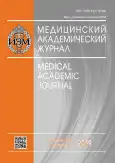THE EFFECT OF CHEMOKINE CXCL-13 ON THE CLINICAL AND FUNCTIONAL STATUS OF PATIENTS WITH MULTIPLE SCLEROSIS IN REMISSION
- Authors: Sursiakova NV1, Kuklina EM2, Baidina TV1, Nekrasova IV2
-
Affiliations:
- E.A. Vagner’s Perm State Medical University, Perm
- Institute of Ecology and Genetics of Microorganisms, the Ural Branch of the Russian Academy of Science, Perm
- Issue: Vol 19, No 1S (2019)
- Pages: 117-119
- Section: Articles
- Published: 15.12.2019
- URL: https://journals.eco-vector.com/MAJ/article/view/19356
- ID: 19356
Cite item
Abstract
Introduction. CXCL-13 can be involved in the development of MS, and its level in peripheral blood may have diagnostic and / or prognostic significance. The purpose of this study is to assess the level of CXCL-13 in serum and its relationship with the clinical and functional state of patients with remitting MS in remission. Materials and methods. The study involved 67 patients (28 men and 39 women) with a relapsing MS in remission. All patients were examined by scales and questionaries EDSS, Multiple Sclerosis Functional Composite, Multiple Sclerosis Impact Scale 29, Fatigue Severity Scale. On the day of the clinical examination venous blood samples were taken from patients and healthy donors, serum was isolated, and the level of CXCL-13 was assessed by enzyme immunoassay method. Results and discussion. It was revealed that CXCL-13 in the serum in patients with MS was significantly lower than in healthy volunteers. A relationship was found between serum CXCL-13 and the severity of neurological deficit according to EDSS, with walking speed of 25 feet, with an assessment of the quality of life and fatigue. Conclusions. Despite the association of CXCL-13 with the clinical and functional state of MS patients, at present time this chemokine cannot be considered to be a diagnostic or prognostic marker in MS patients.
Full Text
About the authors
N V Sursiakova
E.A. Vagner’s Perm State Medical University, Perm
E M Kuklina
Institute of Ecology and Genetics of Microorganisms, the Ural Branch of the Russian Academy of Science, Perm
T V Baidina
E.A. Vagner’s Perm State Medical University, Perm
I V Nekrasova
Institute of Ecology and Genetics of Microorganisms, the Ural Branch of the Russian Academy of Science, Perm
References
- Disanto G, Morahan J, Barnett M, et al. The evidence for a role of B cells in multiple sclerosis. Neuro¬logy. 2012;78(11):823-832.
- Havenar-Daughton С, Lindqvist М, Heit А, et al. CXCL13 is a biomarker of germinal center activity. Proceedings of the National Academy of Sciences. 2016;113(10):2702-2707.
- Shi G, Zhang Z, Li Q. New Biomarkers in Autoimmune Disease. Journal of Immunology Research. 2017;2017:1-2.
- Ragheb S, Li Y, Simon K, et al. Multiple sclerosis: BAFF and CXCL13 in cerebrospinal fluid. Multiple Sclerosis Journal. 2011;7(7):819-829.
- Edwards KR, Goyal J, Plavina, et al. Feasibility of the Use of Combinatorial Chemokine Arrays to Study Blood and CSF in Multiple Sclerosis. PLoS ONE. 2013;8(11):10-13.
- Novakova L, Axelsson M, Khademi M, et al. Cerebrospinal fluid biomarkers as a measure of disease acti¬vity and treatment efficacy in relapsing-remitting multiple sclerosis. J. Neurochem 2017;141:296-304.
Supplementary files







